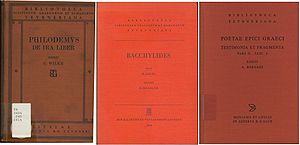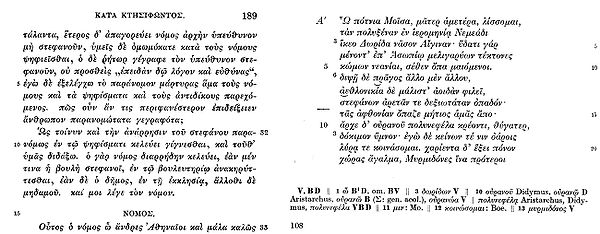
Bibliotheca Teubneriana
Encyclopedia

Ancient Greek literature
Ancient Greek literature refers to literature written in the Ancient Greek language until the 4th century.- Classical and Pre-Classical Antiquity :...
and Latin
Latin literature
Latin literature includes the essays, histories, poems, plays, and other writings of the ancient Romans. In many ways, it seems to be a continuation of Greek literature, using many of the same forms...
texts, comprise the most thorough modern collection ever published of ancient (and some medieval) Greco-Roman literature. The series, whose full name is the Bibliotheca Scriptorum Graecorum et Romanorum Teubneriana, consists of critical editions
Textual criticism
Textual criticism is a branch of literary criticism that is concerned with the identification and removal of transcription errors in the texts of manuscripts...
by leading scholars (now always with a full critical apparatus
Critical apparatus
The critical apparatus is the critical and primary source material that accompanies an edition of a text. A critical apparatus is often a by-product of textual criticism....
on each page, although during the nineteenth century some editiones minores were published either without critical apparatuses or with abbreviated textual appendices).
Teubneriana is an abbreviation used to denote mainly a single volume of the series (fully: editio Teubneriana), rarely the whole collection; correspondingly, Oxoniensis is used with reference to the Scriptorum Classicorum Bibliotheca Oxoniensis, mentioned above as Oxford Classical Texts.
Today, the only comparable publishing ventures, producing authoritative scholarly reference editions of numerous ancient authors, are the Oxford Classical Texts
Oxford Classical Texts
Oxford Classical Texts , or Scriptorum Classicorum Bibliotheca Oxoniensis, is a series of books published by Oxford University Press. It contains texts of ancient Greek and Latin literature, such as Homer's Odyssey and Virgil's Aeneid, in the original language with a critical apparatus...
and the Collection Budé
Collection Budé
The Collection Budé, or the Collection des Universités de France, is a series of books comprising the Greek and Latin classics up to the middle of the 6th century...
(whose volumes also include facing-page French translations with notes). (The Loeb Classical Library
Loeb Classical Library
The Loeb Classical Library is a series of books, today published by Harvard University Press, which presents important works of ancient Greek and Latin Literature in a way designed to make the text accessible to the broadest possible audience, by presenting the original Greek or Latin text on each...
, with facing-page English translations and notes, aims at a more general audience.)
History of the series
In 1811, Benedictus Gotthelf Teubner (1784-1856) refounded in his own name a printing operation he had directed since 1806, the Weinedelsche Buchdruckerei, giving rise to the LeipzigLeipzig
Leipzig Leipzig has always been a trade city, situated during the time of the Holy Roman Empire at the intersection of the Via Regia and Via Imperii, two important trade routes. At one time, Leipzig was one of the major European centres of learning and culture in fields such as music and publishing...
publishing house of B.G. Teubner (its imprint, in Latin, in aedibus B.G. Teubneri). The volumes of the Bibliotheca Teubneriana began to appear in 1849. Although today Teubner editions are relatively expensive (as are European-produced scholarly books in general), they were originally introduced to fill the need, then unmet, for low-priced but high-quality editions.
Prior to the introduction of the Teubner series, accurate editions of antique authors could only be purchased by libraries and rich private scholars because of their expense. Students and other individuals of modest means had to rely on editions which were affordable but also filled with errors. To satisfy the need for accurate and affordable editions Teubner introduced the Bibliotheca Teubneriana.
In the 19th century, Teubner offered both affordable editiones maiores (with a full critical appartus) for scholars, and low-priced editiones minores (without critical apparatuses or with abbreviated textual appendices) for students. Eventually, editiones minores were dropped from the series and Teubner began to offer only scholarly reference editions of ancient authors.
During the period between the end of World War II
World War II
World War II, or the Second World War , was a global conflict lasting from 1939 to 1945, involving most of the world's nations—including all of the great powers—eventually forming two opposing military alliances: the Allies and the Axis...
and German reunification
German reunification
German reunification was the process in 1990 in which the German Democratic Republic joined the Federal Republic of Germany , and when Berlin reunited into a single city, as provided by its then Grundgesetz constitution Article 23. The start of this process is commonly referred by Germans as die...
, the publishing house of B.G. Teubner split into two firms, one in Leipzig in East Germany, and one in Stuttgart
Stuttgart
Stuttgart is the capital of the state of Baden-Württemberg in southern Germany. The sixth-largest city in Germany, Stuttgart has a population of 600,038 while the metropolitan area has a population of 5.3 million ....
in West Germany. Both offered volumes in the Bibliotheca Teubneriana.
After the fall of the Berlin wall and the reunification of Germany, B.G. Teubner was also reunited and subsequently consolidated its headquarters at Wiesbaden
Wiesbaden
Wiesbaden is a city in southwest Germany and the capital of the federal state of Hesse. It has about 275,400 inhabitants, plus approximately 10,000 United States citizens...
.
In late 1999, B.G. Teubner Verlag announced their intention to concentrate on scientific and technical publishing. All their Classical Studies titles, including the Biblotheca Teubneriana, were sold to K.G. Saur, a publisher based in Munich
Munich
Munich The city's motto is "" . Before 2006, it was "Weltstadt mit Herz" . Its native name, , is derived from the Old High German Munichen, meaning "by the monks' place". The city's name derives from the monks of the Benedictine order who founded the city; hence the monk depicted on the city's coat...
. Although new volumes began to appear with the imprint in aedibus K.G. Saur, the name of the series remained unchanged.
In 2006, the publishing firm of Walter de Gruyter
Walter de Gruyter
Walter de Gruyter GmbH & Co. KG is a scholarly publishing house specializing in academic literature. Its origins date back to 1749 when it was given the right to print books by King Frederick II of Prussia. -De Gruyter Mouton:...
acquired K.G. Saur and their entire publishing range, including the Bibliotheca Teubneriana. Since January 2007, the Bibliotheca Teubneriana is being exclusively published by Walter de Gruyter GmbH & Co. KG. As of 1 May 2007, the new North American distributor of titles from the Bibliotheca Teubneriana is Walter de Gruyter, Inc.
Greek Type in Teubner Editions
While the typographyTypography
Typography is the art and technique of arranging type in order to make language visible. The arrangement of type involves the selection of typefaces, point size, line length, leading , adjusting the spaces between groups of letters and adjusting the space between pairs of letters...
of the Greek Teubners has been subject to innovations over the years, an overview of the whole series shows a great deal of consistency. The old-fashioned, cursive
Italic type
In typography, italic type is a cursive typeface based on a stylized form of calligraphic handwriting. Owing to the influence from calligraphy, such typefaces often slant slightly to the right. Different glyph shapes from roman type are also usually used—another influence from calligraphy...
font used (with small variations) in most of the existing volumes is instantly recognized by classicists and strongly associated with Teubner.
Original "Teubner" Font

Porson (typeface)
Porson is a typeface in the Greek alphabet based on the handwriting of the English classicist Richard Porson, who, as his biographer writes, "excelled ... in writing with neatness and beauty" and "wrote notes on the margins of books with such studied accuracy that they rivalled print".The face was...
standard more familiar in the English-speaking world) are still found which would later be smoothed away, for example, omega with bent-in ends, medial sigma that is not completely closed, and phi with a bent stem.
Upright Variant

Digital Descendants

Euripides
Euripides was one of the three great tragedians of classical Athens, the other two being Aeschylus and Sophocles. Some ancient scholars attributed ninety-five plays to him but according to the Suda it was ninety-two at most...
tragedies were digitally typeset in a font apparently based on the original Teubner cursive. There have also been recent innovations in upright type. One of these, which may be seen in Bernabé's edition of the Orphica, seems likely to be the current standard for new Teubners from K.G. Saur.
Griechische Antiqua

More recently there has been a welcome and long overdue return to the older and purer models. The pleasing modification of M.E. Pinder's "Griechische Antiqua" used by Teubner in some of their editions represents a lost opportunity, having been regrettably abandoned in favour of the "dull and lumpish" fount (Victor Scholderer's words) that is still the uniform of the series.Kenney referred to Bruno Snell's Bacchylides edition of 1934; closely comparable is the Philodemus example illustrated here. A slightly less radical version of this font (notably without lunate sigma) was used in some later Teubner editions (and in non-Teubner publications such as Rahlfs'
Alfred Rahlfs
Alfred Rahlfs was born in Linden, Hannover, Germany. He studied Protestant Theology, Philosophy, and Oriental Languages in Halle and Göttingen, from where he received a Dr. Phil. in 1881...
Septuaginta of 1935), and M.L. West's
Martin Litchfield West
Martin Litchfield West is an internationally recognised scholar in classics, classical antiquity and philology...
recent edition of the Iliad
Iliad
The Iliad is an epic poem in dactylic hexameters, traditionally attributed to Homer. Set during the Trojan War, the ten-year siege of the city of Troy by a coalition of Greek states, it tells of the battles and events during the weeks of a quarrel between King Agamemnon and the warrior Achilles...
uses a digital font that seems closer to this type than to the main Teubner tradition.
External links
- Listing of titles from the publisher, K.G. Saur

